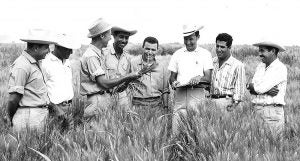After writing about the wizardry of Norman Borlaug and others providing the seeds for a “Green Revolution,” I found out one of my adult daughters, born in the 1960s, had never heard of Borlaug and the Green Revolution. And I got to wondering how many people of that and succeeding generations, even with agricultural exposure, have no appreciation for the food deficits and starvation that stalked Third World countries in the 1960s and ’70s.
In the 1968 book titled The Population Bomb, Paul Ehrlich argued for a sort of triage, saying food surplus countries could not possibly feed the burgeoning populations of South Asia, especially Pakistan and India. We would have to give up trying to feed everyone. Millions would have to starve. China could not feed itself, and even as Ehrlich wrote, Mao Zedong’s Cultural Revolution was causing mass starvation in the Chinese countryside.
Borlaug never intended to start a Green Revolution. His assignment from the Rockefeller Foundation was to provide Mexican farmers with rust resistant varieties of wheat. His qualifications for the job were a doctorate in plant pathology with expertise in forest rusts. And because he ignored some of the tenants of wheat breeding, he serendipitously created varieties with worldwide adaptation.
The story of the Green Revolution begins in Japan right after World War II. A U.S. Department of Agriculture agronomist, S.C. Salmon, was assigned to the Army of Occupation. He toured Japanese farms, and their wheat varieties with short, stiff straw and heavy seed heads caught his eye.
He took samples of 16 strains and sent them to breeders at land grant universities in the U.S. The only breeder who made crosses with them was Orville Vogel, the USDA wheat breeder at Washington State College (now University).
» Related: Modern-day agricultural heroes: Celebrating pioneers in crop ag
One variety, Norin 10, was of special interest to Vogel. It was a dwarf wheat, and Vogel wanted to shorten the straw of his varieties to prevent lodging. Vogel crossed it with Brevor, a popular Pacific Northwest variety in the 1950s. The result was the variety Gaines, the first yield-busting semi-dwarf wheat, which was released to farmers in 1961.
By the 1950s, Borlaug had developed rust-resistant wheats for Mexican farmers, and they had begun using nitrogen fertilizers, so they now had a lodging problem. Borlaug heard about Vogel’s program and paid him a visit. Vogel told him his selections would not work in Mexico because they were winter wheats, and Borlaug’s varieties were spring wheats. However, Borlaug took two of Vogel’s selections back to Mexico and started making crosses.
In 1960, Borlaug was ready to show some of his team’s crosses to farmers at a field day. What happened is a testament to the ability of Third World farmers to recognize superior technology and put it to work, a trait often denied by NGOs who insist on using local varieties and technologies when working with subsistence farmers in developing countries. Author Lennard Bickel relates the story in his biography of Borlaug, Facing Starvation, as follows:
When Borlaug had his first field day in the 1940s, no one came. Now they came from far and wide. Borlaug was a hero to Mexican farmers. Flatbed trucks and trailers were used to transport attendees around the thousands of plots, stopping regularly so that the agronomos (agronomists) Borlaug had trained could lecture the farmers. The farmers were told to stay on the trucks, but when they stopped at the plots displaying the short wheats, no one waited for the lecture. They jumped off the trucks and began grabbing wheat heads and stuffing them in their pockets. The alarmed agronomos tried to push them back, and fistfights broke out. When the melee was over and the trucks moved on, 20 percent of the new, short-strawed plants left in the pockets of the farmers. The agronomo in charge was upset, he didn’t even get to give his lecture. The farmers didn’t need a lecture, they knew a good thing when they saw it. The next summer, Borlaug toured the wheat growing area and saw small patches of his shorty wheat growing everywhere.
Borlaug made three wheat breeding innovations that foreshadowed his remarkable contributions to feeding the world. The first was high-volume crossbreeding. Most breeders only made a few crosses per year. It is painstaking work, pulling anthers from the heads before they shed pollen, then masking the head with paper to keep out foreign pollen, finally revisiting the head with desired pollen when the ovary is ready. And of course recording everything in a record book as they go. Borlaug at first made hundreds of crosses, then, with students, thousands each year.

His second innovation was shuttle breeding. Over the objections of seasoned breeders that it wouldn’t work, Borlaug started growing two generations per year, one in the winter in northeastern Mexico near Obregon, and another in the summer on high altitude farms near Mexico City. Starting with photoperiodic varieties (sensitive to day length), he unknowingly selected for plants that grew well whether days were getting longer or shorter. Therefore he serendipitously adapted his varieties to a wide range of growing conditions, as they initiated flowering in response to accumulated heat units instead of day length. In addition, his selections were exposed to different soils, different diseases, and different climates.
Borlaug’s third innovation was to duplicate Vogel’s success in dwarfing the wheat plant. Mexico got its first semi-dwarf wheat the same year it was introduced in the PNW: 1961.
Within a couple years, Borlaug’s varieties were being tested in Pakistan and India. By the end of the decade, India and Pakistan were self-sufficient in wheat production, and the Revolution extended west to Turkey. Borlaug was awarded the Nobel Peace Prize in 1970. His grit and determination had made unrest, even war, over food very unlikely. Together with the contribution of scientists breeding rice and other crops, and improved farming methods, mass starvation was banned from South Asia for the rest of the century and to the present day. But the Green Revolution has its critics.
Next month we will examine those arguments.
Jack DeWitt is a farmer-agronomist with farming experience that spans the decades since the end of horse farming to the age of GPS and precision farming. He recounts all and predicts how we can have a future world with abundant food in his book “World Food Unlimited.” A version of this article was republished from Agri-Times Northwest with permission.



